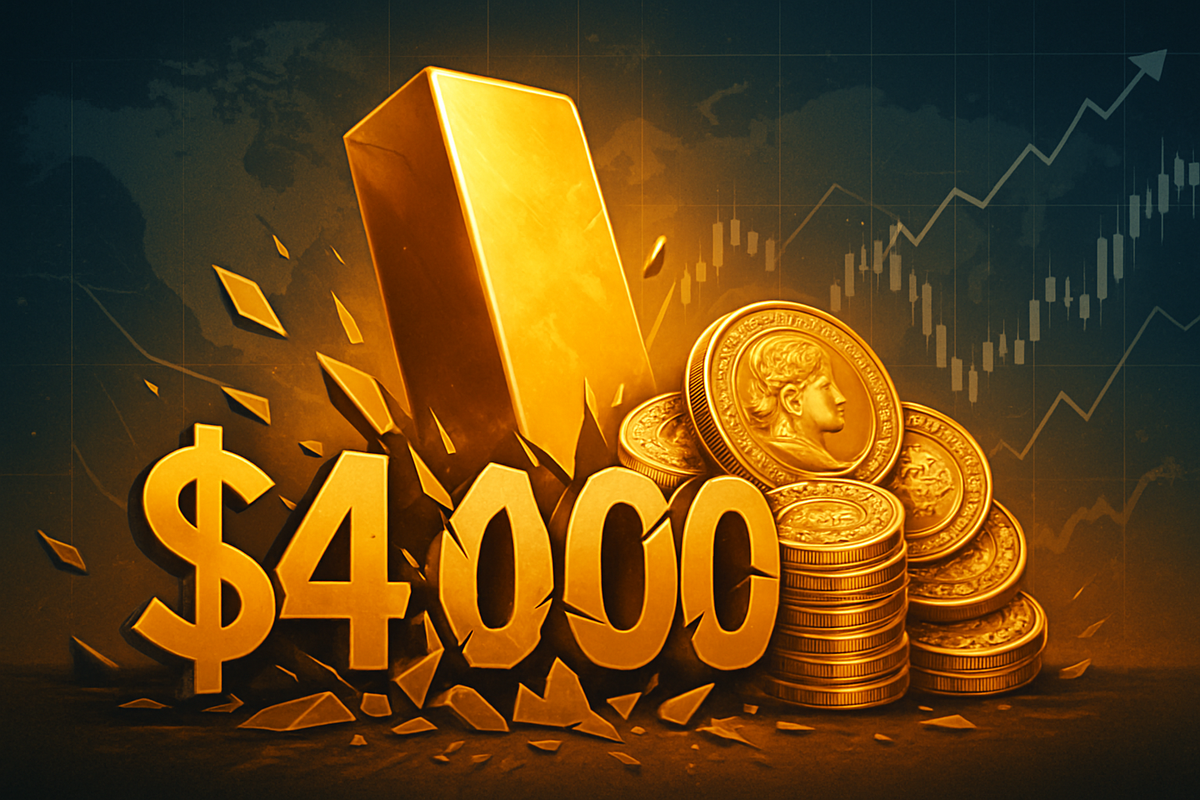
Gold has officially surged past the unprecedented $4,000 an ounce level for the first time in history as of October 2025, building on a relentless, record-breaking rally that shows no signs of abating. This monumental breakthrough is not merely a psychological milestone but a profound indicator of deep-seated shifts in global financial markets and investor sentiment, signaling an intensifying flight to safety amidst a complex tapestry of economic uncertainties and geopolitical tensions. The immediate implication is a reinforcement of gold's role as the paramount safe-haven asset, with investors increasingly seeking secure stores of wealth and a hedge against the perceived debasement of traditional currencies.
The sustained upward trajectory of gold, defying conventional market wisdom, has significant ramifications for central bank policies, currency valuations, and the broader asset allocation strategies of institutional and retail investors alike. As the precious metal continues its ascent, it forces a re-evaluation of risk, return, and the very foundations of financial stability in an increasingly volatile world.
The Golden Ascent: A Timeline of Unprecedented Gains
The journey to $4,000 an ounce has been nothing short of historic. Gold's current rally is described as one of the strongest since 1979, having surged over 50% year-to-date in 2025, following a substantial 27% rise in 2024. This consistent upward momentum, even in periods traditionally unfavorable for gold (like earlier phases of higher interest rates), underscores its resilience and growing importance as a store of value.
The specific details of this rally highlight a confluence of powerful drivers. Persistent global economic uncertainty, including fears of a looming U.S. recession and ballooning government debt levels worldwide, has propelled investors towards gold. A pivotal factor has been the Federal Reserve's anticipated rate-cutting cycle through 2025. Lower interest rates significantly reduce the opportunity cost of holding non-yielding assets like gold, making it a more attractive investment.
Key players driving this demand include central banks globally, particularly those in emerging markets, which have been aggressively accumulating gold reserves at "significantly elevated levels." This strategic rebalancing aims to diversify reserves, reduce dependence on potentially vulnerable currencies like the U.S. dollar, and safeguard against financial turmoil. Central bank buying has been a primary demand driver, with over 1,000 tonnes purchased annually for the third consecutive year. Geopolitical tensions, such as ongoing conflicts in Ukraine and Gaza, alongside political instability in various regions, further fuel this flight to safety. A weakening U.S. dollar and a broader global trend of "de-dollarisation" also make gold more appealing to international buyers. Initial market reactions have seen significant inflows into gold-backed Exchange-Traded Funds (ETFs) and increased hedging by retail investors, with a palpable "fear of missing out" (FOMO) phenomenon boosting the rally.
Public Companies in the Golden Crosshairs: Winners and Losers
The unprecedented surge in gold prices to $4,000 an ounce creates a distinct landscape of winners and losers within the public market, dramatically reshaping the fortunes of companies tied to the precious metal.
The Winners: Gold mining companies stand to be the most direct beneficiaries of this rally. Higher gold prices translate directly into significantly fatter profit margins, as their cost of extraction remains relatively stable while the revenue per ounce skyrockets. Major gold producers like Newmont Corporation (NYSE: NEM), Barrick Gold Corporation (NYSE: GOLD), and Agnico Eagle Mines Limited (NYSE: AEM) are experiencing a boom. Their stock prices have surged, reflecting increased investor confidence in their future earnings potential. These companies are now incentivized to expand exploration efforts, bring marginal projects online, and potentially increase dividends or initiate share buybacks, further attracting investors. Smaller, junior mining companies engaged in exploration and development also see their valuations soar, as previously uneconomical deposits become highly viable. This environment also benefits companies providing services to the mining industry, such as equipment manufacturers and engineering firms.
The Losers (or those facing challenges): While fewer direct "losers" exist from rising gold prices, certain sectors and companies may face indirect headwinds. Industries that utilize gold as a significant input cost, such as jewelry manufacturers and high-end electronics producers, may see increased operational costs. While these companies often pass costs onto consumers, a sustained rally could impact demand or necessitate adjustments to pricing strategies, potentially squeezing margins. Companies heavily reliant on a strong U.S. dollar might also face indirect pressure as gold's rise often correlates with dollar weakness, affecting their international earnings when converted back to the depreciating greenback. Furthermore, in an environment where gold is seen as a superior safe-haven, some capital might flow out of other traditional asset classes, potentially impacting valuations in sectors that thrive on speculative investment rather than intrinsic value, although this is a broader market dynamic rather than a direct negative impact from gold itself.
The sustained high price of gold also means that companies with significant debt denominated in currencies other than gold (which is virtually all of them) may find their real debt burden effectively increasing if their revenues are not keeping pace with the perceived debasement of fiat currencies that gold's rally implies. However, for most companies, the impact is less direct than for those in the mining sector. The primary takeaway is a significant boost for gold producers, making them attractive investments in the current climate.
Wider Significance: A Reordering of Global Finance
Gold's breach of the $4,000 mark is far more than a simple price milestone; it signifies a profound reordering of global financial priorities and a powerful statement on the state of the world economy. This event fits into broader industry trends marked by increasing de-dollarisation efforts by central banks, a persistent search for inflation hedges, and a growing distrust in the long-term stability of fiat currencies.
The potential ripple effects on competitors and partners are substantial. As gold gains prominence, it could divert investment flows from other safe-haven assets or alternative stores of value, such as certain government bonds or even, to some extent, cryptocurrencies, which have also seen significant rallies but might now face stiffer competition for safe-haven capital. The heightened allure of gold could also pressure central banks globally to further diversify their reserves, accelerating the trend away from excessive reliance on the U.S. dollar. This has significant geopolitical implications, potentially altering the balance of power in international finance.
Regulatory or policy implications might emerge if the rally continues unchecked. Governments and financial authorities might consider measures to stabilize markets or address concerns about speculative bubbles, though direct intervention in the gold market is historically rare. However, the underlying drivers – government debt, inflation, and monetary policy – are squarely within the purview of policymakers. The rally could intensify calls for fiscal prudence and a reassessment of monetary easing strategies.
Historically, major gold rallies have often coincided with periods of significant economic upheaval, geopolitical instability, or high inflation. The current environment, characterized by ongoing conflicts, record national debts, and central banks navigating complex monetary policies, bears striking resemblances to past eras of gold ascendancy, such as the 1970s. This historical precedent suggests that the current rally is not an anomaly but a rational response to prevailing global conditions, reinforcing gold's role as a timeless hedge against systemic risks. The sustained nature of this rally suggests a deeper, more structural shift in investor confidence rather than a fleeting speculative fervor.
What Comes Next: Navigating the Golden Future
The path forward for gold, having shattered the $4,000 barrier, presents both intriguing possibilities and potential challenges. In the short-term, technical indicators suggest gold is in "extreme overbought" territory, implying that some profit-taking or minor pullbacks could occur. However, expert consensus indicates that any dips are likely to be limited and should be viewed as buying opportunities, given the strong underlying fundamental drivers. The immediate focus will be on gold's ability to consolidate above this new psychological level and establish it as a new floor.
Long-term possibilities include gold continuing its ascent towards even higher price targets, with some analysts now forecasting $5,000 an ounce as the next major milestone. This trajectory would be sustained by ongoing central bank demand, persistent geopolitical tensions, and continued concerns over global debt and currency debasement. The "fiscal dominance" signal, where investors lose confidence in governments' ability to manage debt without monetary accommodation, suggests that gold's role as a hedge against sovereign risk will only strengthen.
Potential strategic pivots or adaptations will be required across financial markets. Investors might increasingly reallocate portfolios towards tangible assets and away from traditional financial instruments, especially if real interest rates remain low or turn negative. Central banks might accelerate their de-dollarisation efforts, further diversifying their reserves with gold. Market opportunities will emerge in gold-related investments, including mining stocks, gold ETFs, and even innovative financial products designed to track gold's performance. Conversely, challenges might arise for sectors sensitive to inflation or currency depreciation, requiring them to adapt their business models or hedging strategies.
Potential scenarios and outcomes range from a continued, albeit volatile, bull run for gold, driven by the current "toxic cocktail of pressures," to a more moderated pace of appreciation if global economic stability improves or geopolitical tensions ease. However, given the entrenched nature of the current drivers, a significant reversal appears less likely in the near to medium term. The most probable scenario is gold maintaining its elevated status, becoming a cornerstone of diversified investment portfolios globally.
Comprehensive Wrap-Up: Gold's Enduring Significance
Gold's historic surge past $4,000 an ounce marks a pivotal moment in financial history, underscoring its enduring significance as a store of value and a safe haven. The key takeaways from this event are clear: a profound loss of confidence in fiat currencies, driven by ballooning government debt and accommodative monetary policies; escalating geopolitical instability; and unprecedented central bank demand. These factors have converged to create an environment where gold is no longer just a hedge but a primary asset class attracting significant capital flows.
Moving forward, the market is poised for continued volatility, but with a strong underlying bullish sentiment for gold. The rally is not a speculative bubble but a fundamental recalibration of asset valuations in response to global systemic risks. Investors should assess their portfolios for adequate exposure to gold, considering its role as a diversifier and a protector of purchasing power. The "debasement trade" is firmly in play, and gold is its primary beneficiary.
The lasting impact of this event will likely be a permanent shift in how investors and central banks view and utilize gold. It solidifies gold's position as a critical component of global financial architecture, challenging the dominance of traditional reserve currencies. What investors should watch for in the coming months are further central bank purchasing data, the trajectory of interest rates, any escalation or de-escalation of geopolitical conflicts, and indicators of inflation. These factors will continue to shape gold's path, but the message from the market is clear: gold is back, stronger than ever, and its record-breaking rally is a testament to its timeless appeal in turbulent times.
This content is intended for informational purposes only and is not financial advice







